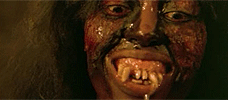Reviews
El hombre y el monstruo
Rafael Baledón
Mexico, 1958
Credits
Review by Matt Bailey
Posted on 16 October 2009
Source CasaNegra DVD
Categories 31 Days of Horror VI
You could be forgiven for wanting to hit the “stop” button a few minutes into Rafael Baledón’s The Man and the Monster, as it begins with just about the hoariest of horror movie clichés: a lone woman drives down a country road and crashes her car into a tree. Shaken, but unharmed, she seeks help at a nearby dilapidated hacienda from which pour the haunting strains of impassioned piano-playing. She knocks on the door. The music stops, but no one comes. She begins to walk away, but is stopped by the grunting voice of a man behind the door, begging to be set free. She looks down to see a set of keys at her feet. Warily, she picks up the key and moves to the locked door. She inserts the key in the lock and slowly turns it. The next shot fills the frame with her screaming face and, splashed atop it, the title of the film, El hombre y el monstruo.
The film then cuts back to the shot that opened the film: a car traveling down the deserted road, but this time it’s a different car. The man driving stops to curse the driver who has blocked the road with her car. Just as he is inspecting the damage to her car, she appears behind him, screams again, and collapses. She is near death, mauled by some ferocious creature. The man runs to the house, knocks on the door, and is greeted by a silent, forbidding woman holding a black cat. She refuses his entreaties for help and closes the door on him. The man returns to the injured woman, and she dies in his arms.
If you have made it these inauspicious five minutes into the film and have committed to watching the remaining seventy-three, you are to be congratulated, for you are about to see one of the best, most interesting, and most unusual horror films to come out of the final flowering of Mexico’s golden age of cinema. Though it is just another of the dozens of movies to issue from the filmmaking factory of brothers Abel and Alfredo Salazar, this film features a twist in the story, uncharacteristic of a horror movie, that lends it genuine pathos, handled with uncommon sensitivity.
The cast of characters is small: our male motorist, Ricardo Souto, is a journalist now determined to solve the mystery of the dead woman but also, conveniently, assigned to write about the scheduled return to the stage of the reclusive pianist, Samuel Magno. Magno, who lives in the same tumbledown house that featured in the first scenes, claims that he can no longer play the piano, but he will be conducting the orchestra for his young protege, Laura, who looks uncannily similar to the woman in a painting that hangs above Magno’s piano. Laura lives with Magno, but there is no romantic involvement. In fact, she is locked in her room every night where she can hear Magno playing the same unearthly sonata again and again. Rounding out the cast is Magno’s mother, Doña Cornelia, the stern woman from the first scenes, who only wants to protect her sensitive son.
Doña Cornelia does her best to prevent Magno from playing the piano because it agitates him, but he explains that he must play and points to another mysteriously locked door within the house. When Ricardo has a chance to explore the house while it is empty, he opens this door to find the corpse of a woman - the same woman from the portrait - clutching a rolled-up piano score. You see, Magno has sold his soul to the devil to become the best pianist in the world, and when he plays the music in this score each night, something terrible happens: he turns into a murderous, wolfman-like monster.
What sets this movie apart from the hundreds of also-rans of the horror genre that flourished in the late-1950s and early-1960s is the manner in which Magno recovers from his transformations. He becomes a man again not when the sun rises, when the moon wanes, or through the kiss of a pure woman, but rather through the touch of his loving mother. At the core of this wild movie intended to frighten little kids, and to give couples on a date a little scare, is a surprisingly tender story about a mother’s unconditional love for her son. This relationship figures in the ending of the film, which is as unexpectedly touching as the end of The Bride of Frankenstein, another horror film that beautifully explores the intersection of monstrosity and human emotion.
A strange combination of Faust with Jekyll and Hyde, served with a dollop of The Phantom of the Opera on the side, The Man and the Monster was directed by the inventive Rafael Baledón, who would go on to write and direct another Mexican horror classic, The Curse of the Crying Woman, which I wrote about for our 31 Days of Horror feature three years ago.) At that point, CasaNegra Entertainment, a boutique DVD label specializing in fully bilingual special editions of Mexican horror films, had just launched. The Curse of the Crying Woman was one of their first two releases, and I applauded them in my review of the film for bringing these extraordinary films to a wider audience. Less than a year and only a handful of releases later, CasaNegra was out of business. The Man and the Monster would be one of their final two releases. DVD titles that had been announced and scheduled, including Alfonso Corona Blake’s marvelously bizarre World of Vampires, would remain unreleased, still teasing “Coming Soon” on CasaNegra’s abandoned website.
In 2007, it was something of a shock to see a DVD label go abruptly kaput. Commenters on DVD forums wondered if some other company could release the titles; rumors abounded that the company would come back. In late 2009, it’s plainly apparent that the demise of the company was just an early harbinger of a disheartening contraction of the DVD marketplace. Boutique DVD labels both new (NoShame films, devoted to vintage Italian genre and arthouse films) and old (New Yorker Films, a decades-old stalwart of independent theatrical and home video distribution) have passed out of existence. Others seem to have sharply scaled back: Fantoma, which has released an eclectic mix of titles by filmmakers such as Kenneth Anger, Rainer Werner Fassbinder, Yasuzo Masumura, and Fritz Lang, has not released anything new for over two years, while Blue Underground, specializing mainly in classic splatter films, appears to be concentrating on making Blu-ray versions of their existing releases than on taking chances with new titles. Something Weird Video, a former mail-order-only outfit that became a peerless leader in exploitation film on widely-distributed DVDs has now gone back to its roots, offering DVD-Rs from its website.
This pullback is not just limited to boutique labels, though. This past March, Warner Home Video launched their burn-on-demand Warner Archive Collection - a way of getting obscure films into the hands of fans - but at the same time seemed to all but cease production of the elegantly curated box sets (Classic Musicals from the Dream Factory and the Signature Collection series, among others) and feature-packed DVDs of classic films that led Slate to call them “the new Criterion Collection” in 2005. Fox Home Entertainment, which against all odds released extraordinarily lavish box sets of their John Ford, Frank Borzage, and F.W. Murnau films in 2007 and 2008, has little else but repackaged films from the past twenty years on their upcoming release slate.
Amid this dark landscape, however, there remain some bright spots. Sony, which had previously been one of the worst of the major studios at getting their classic catalog released, has now become one of the leaders. Box sets of films by Budd Boetticher and Michael Powell released in the last couple of years are being joined by sets devoted to screwball comedies, crime films, films of the “New Hollywood,” and the films of Samuel Fuller. The Criterion Collection, despite the eternal grousing of its fans on certain online discussion forums, continues to put out a brave and diverse selection of films from the work of unheard-of-in-America Japanese directors of the 1930s to arthouse blockbusters from the past year. Kino in the U.S. and Masters of Cinema in the U.K. continue along their merry, eccentric paths while testing the market by boldly putting great silent films on Blu-ray.
Even newer boutique DVD labels are finding ways to thrive: Shameless Screen Entertainment, MYA Communications, and Mondo Vision have joined Severin Films, Dark Sky Films, Synapse Entertainment, and Mondo Macabro in releasing the best (and occasionally the worst) in cult cinema. Would that a successor to CasaNegra was among them to continue to bring interesting yet overlooked films from Mexico like The Man and the Monster to new eyes.
More 31 Days of Horror VI
-

From Beyond
1986 -

The Haunting
1963 -

Killer Klowns from Outer Space
1988 -

Shock ‘Em Dead
1991 -

Critters
1986 -

Critters 2
1988 -

The Fall of the House of Usher
1928 -

Jonestown: The Life and Death of Peoples Temple
2006 -

In the Mouth of Madness
1994 -

Winterbeast
1991 -

Black Roses
1988 -

Needful Things
1993 -

The Seventh Victim
1943 -

A Page of Madness
1926 -

Holocaust 2000
1977 -

The Man and the Monster
1958 -

The Texas Chainsaw Massacre 2
1986 -

Trick or Treat
1986 -

Single White Female
1992 -

Trouble Every Day
2001 -

The Hands of Orlac
1924 -

The Devil’s Advocate
1997 -

Nocturne
1998 -

Hardware
1990 -

Hard Rock Zombies
1985 -

The Slumber Party Massacre
1982 -

Saw VI
2009 -

Zombi 4: After Death
1988 -

The Uninvited
1944 -

Hausu
1977
We don’t do comments anymore, but you may contact us here or find us on Twitter or Facebook.



